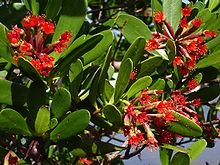

| Myrtales
| |
|---|---|

| |
| Lumnitzera littorea | |
| Scientific classification | |
| Kingdom: | Plantae |
| Clade: | Tracheophytes |
| Clade: | Angiosperms |
| Clade: | Eudicots |
| Clade: | Rosids |
| Clade: | Malvids |
| Order: | Myrtales Juss. ex Bercht. & J.Presl[2] |
| Families | |

The Myrtales are an orderofflowering plants (angiosperms) placed as a sister to the eurosids II clade as of the publishing of the Eucalyptus grandis genome in June 2014.[3]
The APG III systemofclassification for angiosperms still places it within the eurosids; this is corroborated by the placement of the Myrtales in the Malvid clade by the One Thousand Plant Transcriptomes Initiative.[4] The following families are included as of APG III:[2]
The Cronquist system gives essentially the same composition, except the Vochysiaceae are removed to the order Polygalales, and the Thymelaeaceae are included. The families Sonneratiaceae, Trapaceae, and Punicaceae are removed from the Lythraceae. In the classification system of Dahlgren the Myrtales were in the superorder Myrtiflorae (also called Myrtanae). The APG III system agrees with the older Cronquist circumscriptions of treating Psiloxylaceae and Heteropyxidaceae within Myrtaceae, and Memecyclaceae within Melastomataceae.
Ellagitannins are reported in dicotyledoneous angiosperms, and notably in species in the order Myrtales.[5]
Myrtales is dated to around 89–99 million years ago (mya) in Australasia; however, there is some contention as to that date, which was obtained using nuclear DNA. When looking at chloroplast DNA, the myrtales' ancestor is, instead, considered to have evolved during the mid-Cretaceous period (100 mya) in Southeast Africa, rather than in Australasia.[6] Although the APG system classifies myrtales as within the eurosids, the recently published genome of Eucalyptus grandis places the order myrtales as a sister to the eurosids rather than inside them. The discrepancy is thought to have arisen due to the difference between using numerous taxa versus using various genes for constructing a phylogeny.[3]
![]() Data related to Myrtales at Wikispecies
Data related to Myrtales at Wikispecies
|
Orders of flowering plants (APG IV)
| ||||||||||||||||||||||||||||||||||||||||||||||||||
|---|---|---|---|---|---|---|---|---|---|---|---|---|---|---|---|---|---|---|---|---|---|---|---|---|---|---|---|---|---|---|---|---|---|---|---|---|---|---|---|---|---|---|---|---|---|---|---|---|---|---|
| ||||||||||||||||||||||||||||||||||||||||||||||||||
| ||||||||||||||||||||||||||||||||||||||||||||||||||
| ||||||||||||||||||||||||||||||||||||||||||||||||||
| Authority control databases: National |
|
|---|